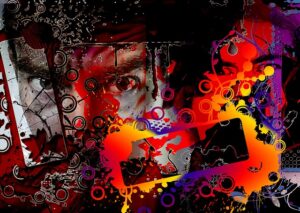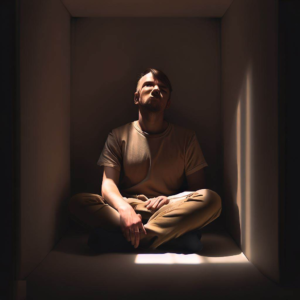Have you ever felt uneasy or even sick at the sight of small holes clustered together? If so, you may suffer from trypophobia.
This phobia is not officially recognized by the Diagnostic and Statistical Manual of Mental Disorders (DSM), but it affects a significant number of people worldwide.
While the fear of small holes might seem irrational to some, there are scientific explanations for why certain patterns trigger reactions in our brains.
In this article, we will dive into the science behind trypophobia and explore what research has revealed about this intriguing phenomenon.
Defining Trypophobia
 Trypophobia is a term used to describe an intense and irrational fear of small holes, clusters of holes or bumps that tend to appear on organic materials like fruits, vegetables, and even human skin.
Trypophobia is a term used to describe an intense and irrational fear of small holes, clusters of holes or bumps that tend to appear on organic materials like fruits, vegetables, and even human skin.
The condition has been recognized as a legitimate phobia in recent years after gaining popularity on social media platforms where individuals shared their aversion towards such patterns.
The cause of trypophobia remains unknown, but researchers have proposed several theories. Some psychologists believe that the fear may stem from an evolutionary response to certain stimuli associated with danger or disease. Others suggest that it could be related to cultural conditioning or past traumatic experiences.
While triggers for trypophobia vary among individuals, common objects known to elicit this reaction include lotus seed pods, honeycomb structures, coral reefs, sponges and even images of pores on the skin.
These seemingly harmless subjects can provoke intense feelings of disgust, anxiety and panic in those who suffer from trypophobia. Understanding the nature and origins of this peculiar phobia remains a challenge for scientists trying to unravel its mysteries.
Prevalence And Symptoms
Having defined trypophobia in the previous section, it is now important to understand its prevalence and symptoms.
Studies have shown that approximately 16% of individuals experience some level of trypophobic aversion, while only a small percentage suffer from severe symptoms.
Symptoms of trypophobia range from mild discomfort to extreme anxiety or panic attacks at the sight of clustered holes or patterns. Some people may also experience physical reactions such as itching, sweating, or nausea. These reactions are caused by an evolutionary response to potential dangers associated with certain patterns found in nature.
Despite popular misconceptions, trypophobia is not a fear of “holes” in general but rather specific clusters that resemble patterns found on poisonous animals or skin diseases. The exact causes for developing this phobia are still being studied; however, researchers believe that genetics and environmental factors could play a role.
Understanding these underlying causes can lead to more effective treatment options for those who suffer from this often-misunderstood phobia.
Theories Behind The Fear
Psychological explanations for trypophobia posit that it arises due to a person’s past experiences with small holes or patterns resembling them. For some individuals, the sight of such patterns may trigger unpleasant memories or feelings of disgust and fear, leading to an aversion towards them. This theory suggests that trypophobia is not innate but develops as a result of learned associations.
On the other hand, evolutionary theories propose that humans have an inherent predisposition towards fearing certain stimuli like clusters of small holes because they resemble dangerous organisms such as venomous spiders or infected wounds. As such, this fear response would have helped our ancestors avoid potential harm in their environment.
However, critics argue that these theories do not fully account for individual differences in phobia development.
Overall, while there are various theories behind the fear of small holes, more research is needed to determine its exact causes and mechanisms. It is likely that multiple factors contribute to its development, including both psychological and biological influences. Understanding trypophobia from different perspectives can help inform effective treatments and interventions for those who suffer from it.
Brain Responses And Triggers
The fear of small holes or trypophobia is a complex condition that affects millions of people worldwide. It triggers a range of physiological responses in the brain, including increased heart rate, sweating, and goosebumps. Brain imaging studies have revealed that seeing images of small clusters of holes can activate regions in the brain associated with disgust and danger.
Physiological arousal is one of the key components of trypophobia. When individuals with this phobia are exposed to stimuli such as lotus pods or honeycomb patterns, their bodies respond with an automatic increase in physiological activity. This response occurs even when they may not be consciously aware of it happening.
Research has also shown that certain visual characteristics, such as high contrast between the hole clusters and surrounding skin, can trigger stronger reactions in individuals with trypophobia. Additionally, some experts suggest that genetics may play a role in determining who develops trypophobia and how severely they experience it.
The degree to which someone experiences trypophobia may depend on their personal threshold for perceived threat.
Exposure therapy has been successful in helping some individuals manage their fear by gradually exposing them to triggering stimuli.
Certain therapies targeting physiological arousal could potentially help alleviate symptoms associated with trypophobia.
Understanding the underlying mechanisms behind trypophobia can provide insight into its treatment and management. By identifying specific triggers and developing effective interventions to decrease physiological arousal, those affected by this phobia may find relief from its distressing symptoms.
Coping Strategies And Treatment Options
Like a diver plunging into the depths of the ocean, those who suffer from trypophobia can feel overwhelmed and consumed by their fear. It’s not just small holes that trigger this phobia; it’s also patterns, bumps, and clusters that evoke intense feelings of disgust or anxiety.
Coping with such overwhelming responses requires learning effective strategies to manage them. One technique is mindfulness meditation, which involves focusing on the present moment without judgment. By practicing mindfulness regularly, individuals may learn to observe their reactions to triggers without becoming caught up in them.
This awareness can help reduce panic and increase clarity about what is happening inside oneself. Therapy sessions can provide additional support for managing trypophobia symptoms. Talking with a licensed mental health professional can help identify underlying causes of one’s fears and develop customized coping mechanisms based on individual needs.
With time and effort, people living with trypophobia can find relief through various treatment options available today.
Is Trypophobia A Recognized Medical Condition?
Research findings have suggested that trypophobia, the fear of small holes or clustered patterns, may not be a recognized medical condition.
While some individuals experience intense discomfort and anxiety in response to images of clusters of holes, others do not exhibit any symptoms at all.
There is also controversy surrounding whether trypophobia should even be considered a true phobia since it does not meet the diagnostic criteria for specific phobias outlined in the DSM-5.
However, more research is needed to fully understand this phenomenon and its potential impact on those who experience it.
Can Trypophobia Be Cured?
While there is no known cure for trypophobia, there are alternative treatments and coping strategies that can help alleviate symptoms.
Acupuncture and hypnotherapy have been suggested as possible alternatives to traditional medication, with some individuals finding relief through these methods.
Additionally, mindfulness practices and desensitization techniques may also be effective in managing the fear associated with small holes.
While further research is needed to determine the effectiveness of these options, they offer hope for those struggling with trypophobia.
Is There A Genetic Component To Trypophobia?
Imagine a puzzle with countless small pieces that come together to form an intricate pattern.
Now imagine feeling uneasy or even afraid when looking at this puzzle, despite how beautiful it may be.
This is similar to what individuals with trypophobia experience when encountering clusters of small holes or bumps on various surfaces such as skin, plant pods, and coral reefs.
While the causes of trypophobia are still being studied, there is evidence suggesting a genetic predisposition and heritability factors could play a role in its development.
Researchers have found that those with family members who also have trypophobia are more likely to develop this fear themselves, indicating a possible inherited component.
Further studies are needed to fully understand the connection between genetics and trypophobia, but these findings highlight the importance of exploring both environmental and genetic factors when investigating phobias.
Can Exposure Therapy Help Individuals With Trypophobia?
Exposure therapy has been shown to be an effective treatment for various phobias, but its effectiveness in treating trypophobia is still uncertain. However, there are alternative treatments such as cognitive-behavioral therapy and medication that have also shown promising results.
While exposure therapy can desensitize individuals to their fear of small holes by gradually exposing them to images or objects associated with it, it may not work for everyone and could even worsen symptoms in some cases. Therefore, a personalized approach should be taken when determining the best course of treatment for those suffering from trypophobia.
Are There Any Medications That Can Help Alleviate Trypophobia Symptoms?
Alternative therapies and cognitive behavioral therapy have shown promise in helping individuals with trypophobia manage their symptoms.
However, there are currently no medications specifically designed to alleviate the fear of small holes.
While some people may find relief from taking anti-anxiety or antidepressant medication, these drugs do not target the root cause of trypophobia.
Instead, alternative approaches such as exposure therapy and CBT can help individuals gradually desensitize themselves to triggers and learn coping mechanisms to better handle anxiety-provoking situations.
As research into trypophobia continues, it is hoped that new treatments will be developed that can provide even more effective relief for those who suffer from this condition.
While trypophobia may not be officially recognized as a medical condition by the DSM-5, it is still a very real fear for many individuals.
Research suggests that there may be a genetic component to this phobia and exposure therapy has shown some promise in helping those who suffer from it.
However, finding a cure or effective treatment for trypophobia remains an ongoing challenge.
It is important for researchers and clinicians to continue studying this phenomenon so that they can better understand its causes and develop more effective treatments.
In the meantime, those who struggle with trypophobia should seek support from mental health professionals and loved ones to help them manage their symptoms and overcome their fears.





